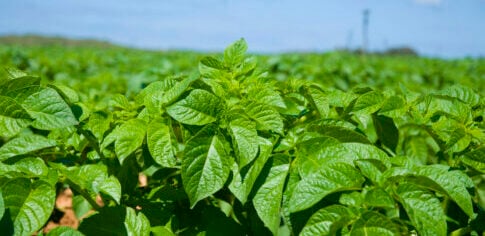Growing Potato crop nutrition advice
Everything you need to know about fertilising potatoes, best practice, suitable products, field trials and more.
Crop nutrition advice for growing potato
-
Potatoes perform best in soil with a pH between 5.5 and 6.7.
-
Potatoes thrive well and give the best yield in sandy loam to slit loam organically rich and well-drained soil.
-
In soils with a high pH (above 7.5) phosphorus mainly, but also other micronutrients deficiencies may appear.
-
In high pH conditions potatoes are susceptible to scab bacterial infection caused by Streptomyces scabies.
-
The optimum conditions for root development and tuber initiation are well drained, aerated soils, with temperatures between 15 and 20 °C.
-
Shorter days will help tuber initiation whereas longer days will delay it.

Potato plants with healthy leaves

Potatoes harvested in optimum condition
Nutrient requirements
Estimated nutrient uptake (kg/t) by:
| N | P2O5 | K2O | MgO | SO3 | CaO | |
|---|---|---|---|---|---|---|
| Kg/ha | Kg/ha | Kg/ha | Kg/ha | Kg/ha | Kg/ha | |
| Tubers | 3 | 1.5 | 6.5 | 0.4 | 0.7 | 0.5 |
| Above ground biomass | 1.9 | 0.6 | 5.3 | 0.2 | 0.4 | 0.25 |
Source: IPNI
Role of nutrients
Key parameter N P2O5 K2O MgO CaO SO3
Yield ++ + ++ + +/- +/-
Tuber size ++ ++ +
Tuber weight ++ + ++
Skin set - + +
Bruising and handling - + ++ ++
Tuber color (internal blackening) +/- +
Dry matter content - +/- - +/-
Starch content - + +/-
+ = improving
– = decreasing
+/- = different results, depending on the rate of nutrient applied
Source: IPI bulletin – Fertilising for high yield | POTATO
Nutrient deficiencies
| Nutrient | Description | |
|---|---|---|
| Nitrogen | Leaves are pale green (general chlorosis) Old leaves remain yellow, while younger leaves turn darker Plants will produce less stems and tubers |
|
| Phosphorous | Plant growth is stunted Darker color than normal Lower leaf surface gray green Leaflets roll upwards if deficiency is severe. It occurs on calcareous and heavy soils, where P can be fixed |
|
| Potassium | Potassium deficiency symptoms normally Scorched appearance with black pigmentation and necrotic edges (dead tissues) Symptoms appear on the young, full-sized leaves Common in light soils due to easier leaching. |
|
| Calcium | Moderate calcium deficiency may not appear but in severe situations leaf’s margin can be affected Brown blotches may appear around the stolon end of the tubers Tubers may show severe skin cracking Deficiencies are severe in soils with pH below 5 |
|
| Magnesium | Chlorosis of leaf margins of older leaves. Yellowing Symptoms appear first on the older leaves, due to its mobility General chlorosis with veins remaining green Scorched appearance caused by interveinal necrosis Can occur on sandy soils and when high K level were applied |
|
| Sulphur | Symptoms are similar to nitrogen deficiency, but Deficiency Symptoms occur first in younger leaves (as yellowing similar N deficiency) General chlorosis The yellowing is uniform and general It may occur on loamy sand soils |




